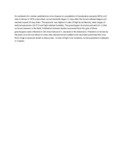| dc.contributor.author | Odindo, MO | |
| dc.date.accessioned | 2015-09-17T08:19:01Z | |
| dc.date.available | 2015-09-17T08:19:01Z | |
| dc.date.issued | 1983 | |
| dc.identifier.citation | Insect Science and its Application 1983 Vol. 4 No. 3 pp. 291-298 | en_US |
| dc.identifier.uri | http://www.cabdirect.org/abstracts/19840508308.html?resultNumber=8&q=au%3A%22Odindo%2C+M.+O.%22 | |
| dc.identifier.uri | http://hdl.handle.net/11295/91168 | |
| dc.description.abstract | An outbreak of a nuclear polyhedrosis virus disease in a population of Spodoptera exempta (Wlk.) at 4 sites in Kenya in 1974 is described. Larval mortality began 11 days after the larval outbreak began and reached a peak 10 days later. The epizootic was highest in sites of high larval density, wide ranges of daily temperatures (16.2°C) and high relative humidity. The grasshopper Acrotylus patruelis (H.-S.) fed on larval cadavers in the field. Polyhedral inclusion bodies recovered from the guts of these grasshoppers were infective to 3rd-instar larvae of S. exempta in the laboratory. Predation on larvae by the pied crow (Corvus albus) in some sites reduced larval numbers and may have prevented the virus from rising to epizootic levels in these areas. In sites of high virus incidence, larval populations collapsed in 3 weeks. | en_US |
| dc.language.iso | en | en_US |
| dc.publisher | University of Nairobi | en_US |
| dc.title | Epizootiological observations on a nuclear polyhedrosis of the African armyworm Spodoptera exempta (Walk.). | en_US |
| dc.type | Article | en_US |
| dc.type.material | en | en_US |

